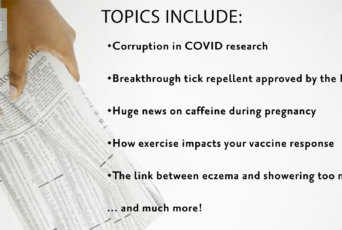Dr. Jess Peatross — aka Dr. Jess — was working at a hospital in Portland, Oregon when she began to have inklings that something wasn’t right with the conventional medical system. She saw her colleagues using a cookie-cutter approach for every problem and sending patients away with laundry lists of prescriptions, and she knew there must be a better way. She left her job in the hospital and launched her own practice, where she now focuses primarily on stealth infections and environmental toxicity, in particular mold. Read on to learn her advice on professional mold testing, why it’s so difficult to do accurate testing for mold toxicity, and more.
You can also listen to our interview with Dr. Jess Peatross on The WellBe Podcast.
Becoming Disillusioned with the Conventional Medical System
Though she’s now an expert in mold and testing for mold toxicity, Dr. Jess had to get to that point completely on her own. “We weren’t taught anything really about mold in medical school,” she says. “They tell you that you can find certain mold balls or fungus in the lungs, and that it would show up in blood work and be a really simple diagnosis. That’s not been my experience at all.”
She explains that her medical training promoted a “cookbook” approach, one that was very mechanical, one that relied on rote memorization: if someone says X, you do Y. “They had taken the art out of medicine,” she says.
Dr. Jess didn’t believe that this way of treating patients was truly helping patients get the best outcome, and so she would go rogue: diving into research that her colleagues dismissed as quackery, suggesting alternative modalities, and just generally straying from the strict protocol her fellow doctors adhered to. When she did that, she was called disruptive, and told that if she continued along that path, she would lose her job.
“The system was really broken and I was having a hard time staying in it, so I left,” she says. “I ended up quitting as a hospitalist, and I had no idea how difficult it would be to build my own business as a holistic doctor, because there’s no system in place for you. You have to be an entrepreneur as well as a doctor. So I sort of did a trial by fire without knowing.”
But she made it through the rough start, and as she began to meet with more clients, she realized that environmental toxins was the area she needed to focus on. “I wanted to get to the root cause for my patients at the time, and that led me to mold, biotoxin illness, and environmental toxins,” she says. “There are plenty of conventional doctors that are told by patients about mold or parasites, and they choose not to hear. So I really think the key take-home point with all of this is that I just chose to believe patients rather than the system.”
Do You Need to Get Professional Mold Testing?
If you do any research on testing for mold toxicity in your home, you’ll soon see that there are a range of different options, with a very large range of different price tags. You can spend a modest amount of money for a DIY at-home mold test, or drop thousands of dollars on professional mold testing done by highly skilled specialists. Deciding which one you need can be very daunting, but Dr. Jess has some helpful advice.
“I really don’t like to find mold in people’s homes,” she says. “It’s the worst part of my job, telling them they have to spend thousands of dollars to remediate or move out. And those are really the only good options, because avoidance in environmental medicine is key to healing. You have to avoid what’s making you sick.”
She advises that before people jump to professional mold testing, they do an at-home mold test. The two types she recommends are the EMMA mold test (environmental mold and mycotoxin assessment) and the ERMI mold test (environmental relative molding index), which run around $300 to $400 dollars — much cheaper than professional mold testing. “Do the test first and make sure you’ve got mold in there. You don’t necessarily need to have an inspector come to your house and diagnose the problem,” she says. “If you suspect mold in your home, it’s really nice to have that at your fingertips and empower yourself to order an affordable test. That way you’re not spending thousands of dollars on someone to come and diagnose.”
But if the test comes back and it looks like you’re in the danger zone for mold toxicity, then it’s time to do professional mold testing. Dr. Jess recommends that people do a lot of thorough research before choosing a mold inspector, however, because they’re not all created equal. “I wish I could vet all the mold inspectors out there and most of them should probably be put through schooling, so that they have some sort of standardized training and they understand the detriments of mold,” she says. “Unfortunately, this isn’t going to happen until the medical system is awake to it either. So we have to do the legwork ourselves here.”
She generally works with a company called YesWeInspect, but there are many other professional mold testing services. When choosing an inspection company, she says, you want to make sure that you choose someone who understands all the nuances of testing for mold toxicity: for instance, that mold isn’t always visible, that it hides behind walls, and that you’re often looking for water damage rather than actual mold growth. “A lot of people in the industry don’t understand that, which is why I often go with YesWeInspect, because if people have the means, I really want to make sure they have things done right,” she says. “I can’t cut corners with mold after what I know. I wouldn’t sleep at night.”
Why Testing for Mold Toxicity and Stealth Inspections Is So Hard
While the professional mold testing described above can help you identify mold toxicity in your home, trying to ascertain whether or not you are sick with mold toxicity is a different story. Despite what Dr. Jess learned in medical school, mold toxicity often does not show up on blood tests, and is actually very tricky to diagnose. Why?
“Pathogens like mold have this really intelligent thing they do. They hide in what’s known as a biofilm, which is like the stuff on your teeth in the morning when you wake up,” she says. “The biofilm acts as a barrier between the pathogen and your immune system. It’s almost like it makes them invisible to your immune system. So that’s a lot of what the pathogens will do, is make themselves very stealthy so they can hide from the immune cells in your body.”
Mold and other pathogens go underground in other ways, too. “These pathogens are often pleomorphic, which means they have the ability to change shape. So, going from a corkscrew bacteria to rolling into a ball or around bacteria,” she explains. “They can also decrease their metabolism so antibiotics don’t get them. They hide out in joint fluid, in the central nervous system, in mucus membranes, not so much in the bloodstream after they underground. And that’s how they stay hidden from our body.”
With testing for mold toxicity, Dr. Jess says, most conventionally trained doctors have no idea how to properly test and diagnose the issue. “They’re going to give you a blood test for antibodies to mold probably,” she explains. “Sometimes, if you’re really really sick, those will be positive, but that’s not the best test for mold at all.”
Instead, she recommends doing a combination of different serum marker tests (she recommends the Mycofix or MycoTOX tests from Great Plains Labs or Vibrant Labs), and then matching those results to a patient’s symptom profile. While it would be nice if we had one surefire mold test that people could rely on, she says that currently that’s not the case. “And to be honest with you, testing is so unreliable, I don’t know if we ever will,” she says.
The Best Mold Test: Taking a Symptoms-First Approach
Because testing for mold toxicity is so challenging and the available mold tests so unreliable, Dr. Jess takes a somewhat unconventional approach, which is to focus on healing symptoms rather than running tests and coming up with a diagnosis. The reason for this, she explains, is because there are crossover symptoms for many stealth infections, and these symptoms will need the exact same treatment regardless of what the actual diagnosis is.
Dr. Jess explains that mold toxicity, in particular, can manifest similarly to Lyme disease, with symptoms such as joint pain, fatigue, brain fog, and extreme thirst. “A lot of these things can overlap,” she says. “So without specific testing, sometimes you don’t know. But I’m not a big tester. I just need to know one or two major things that are in people.”
“So many doctors go after [diagnosing] one thing, then the next thing, then the next thing. They want this cookbook protocol to go through different tests — a mold test first or Lyme first or whatever the doctor thinks is most important. I don’t really understand, because these things are so closely related and our tests are not the Bible,” she says. “So many of our tests are indirect antibody testing, so your immune system has to be working properly for things to show up positive or not. So many tests are lacking.”
Really, she says, patients just need treatment that is effective. For her, this treatment often involves binders (specific compounds that bind up toxins so that they can be more easily eliminated via urine, poop, or sweat), as well as lifestyle changes like eating better and moving more. “I have a protocol where I just don’t even worry what their diagnosis is,” she says. “They come to me ill, and I’m going to work on making sure that all of their organ systems work well.”
If after this treatment a patient still doesn’t feel well, then she drills down on more specific testing for mold toxicity or other infections via the approach recommended above (serum markers matched with symptomatology). “I may need to verify some of my suspicions about your body,” she says. “But I have herbs and binders that help pull things out, and I don’t always need to know exactly what the binder is pulling out as long as I know it’s effective and doesn’t strip their nutrition.”
The WellBe Takeaway on Testing for Mold Toxicity
Mold toxicity is scary and harmful, and testing for it can be overwhelming and very expensive. Here are our key things to remember on the topic from our interview with Dr. Jess Peatross:
- Most doctors are taught very little about mold toxicity in medical school. They’re also taught that any mold toxicity will show up in a blood test, but this is not the case according to Dr. Jess.
- If you have mold in your home, it can be incredibly damaging to the health of you and your loved ones. Unfortunately, professional testing for mold can be prohibitively expensive. Dr. Jess recommends ordering an at home test (like EMMA or ERMI) to see if your mold levels are high enough to warrant paying for a professional mold inspector.
- Testing for mold toxicity in one’s body is also tricky, as mold toxicity can be a stealth infection that doesn’t show up on blood tests. Pathogens like mold have many different tricks to evade detection: hiding inside biofilm, decreasing their metabolism, changing shape, hiding in joint fluid, etc.
- The most accurate mold test involves running several serum marker tests and comparing those to your symptom profile. However, Dr. Jess often avoids testing altogether, as these tests tend to be very unreliable and many stealth infections (such as mold toxicity and Lyme) have very similar symptom profiles and require the same treatment.
Watch our full interview with Dr. Jess Peatross to learn how to give the body more detoxification support when it needs it, how to help your body detoxify if you have a parasitic or microbial infection, why she doesn’t recommend heavy metal testing, why Lyme testing is so controversial, exactly how binders work to remove toxins from your body, why she believes saunas are one of the best forms of detoxification, the best ways to avoid getting a stealth infection or environmental toxicity, her thoughts on long-haul Covid symptoms, and more.
You can also listen to our interview with Dr. Jess Peatross on The WellBe Podcast.
Have you had any experience with mold toxicity? Tell us about it in the comments below!
The information contained in this article comes from our interview with Jess Peatross, MD, a board-certified internal medicine hospitalist and expert in stealth infections, including Lyme disease and mold. She worked as a hospitalist for six years before training in functional medicine, and is the former medical director at Adventist Hospital in Oregon. She is also trained in Gerson therapy, Ozonotherapy, and Neuroemotional Technique. You can learn more about Dr. Jess Peatross on her website.
Citations:
- Vestby LK, Grønseth T, Simm R, Nesse LL. Bacterial Biofilm and its Role in the Pathogenesis of Disease. Antibiotics (Basel). 2020 Feb 3;9(2):59.
- Robertson P, Abdelhady H, Garduño RA. The many forms of a pleomorphic bacterial pathogen-the developmental network of Legionella pneumophila. Front Microbiol. 2014 Dec 22;5:670.
- Weinhold B. A spreading concern: inhalational health effects of mold. Environ Health Perspect. 2007 Jun;115(6):A300-5.








COMMENTS